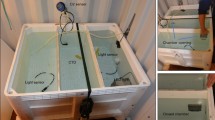Abstract
Lighting systems combining light-emitting diodes (LEDs) and metal halide lamps (MHs) are expected to be energy-saving tools in Japan’s squid jigging fishery. Previous research has shown the need for light stronger than LEDs (9 kW) and 36 MHs (108 kW) to catch the Japanese common squid Todarodes pacificus. We tested a stepwise lighting method termed “stage reduced lighting” in the Tsushima Strait in January and February 2010 using nine fishing boats. LEDs (9 kW) and 50 MHs (150 kW) were lit for 3.9 h on average, and then the number of MHs was reduced to either 30 or 36 until the end of fishing (7.3 h on average). This method reduced fuel consumption by 22–25 % compared to the continuous use of all fishing lamps (159 kW). We carried out a catch analysis of nine experimental boats and 21 commercial boats during the experimental period. Generalized linear modeling analysis suggested that the squid catch can be explained by the illuminated fraction of the moon and monthly changes in squid abundance, and the lighting method. The stage reduced lighting using LEDs and MHs has the potential to reduce fuel consumption while maintaining the squid catch.






Similar content being viewed by others
References
Matsushita Y, Azuno T, Yamashita Y (2012) Fuel reduction for small squid jigging boats by equipping conventional metal halide lamps with combinations of LED panels. Fish Res 125:14–19
Yamashita Y, Matsushita Y, Azuno T (2012) Catch performance of coastal squid jigging boats using LED panels in combination with metal halide lamps. Fish Res 113:182–189
Venables WN, Dichmont CM (2004) GLMs, GAMs and GLMMs: an overview of theory for applications in fisheries research. Fish Res 70:319–337
Venables WN, Ripley BD (2002) Modern applied statistics with S. Springer, New York
Inada H, Ogura M (1988) Historical change of fishing light and its operation in squid jigging fisheries. Rep Tokyo Univ Fish 24:189–207 (in Japanese, with English abstract)
Inada H (1996) Retinomotor response and retinal adaptation of Japanese common squid Todarodes pacificus at capture with jigs. Fish Sci 62:663–669
Arakawa H, Choi S, Arimoto T, Nakamura Y (1998) Relationships between underwater irradiance and distribution of Japanese common squid under fishing lights of squid jigging boat. Fish Sci 64:553–557
Shikata T, Shima T, Inada H, Miura I, Daida N, Sadayasu K, Watanabe T (2011) Role of shaded area under squid jigging boat formed by shipboard fishing light in the process of gathering and capturing Japanese common squid, Todarodes pacificus. Nippon Suisan Gakkaishi 77:53–60 (in Japanese, with English abstract)
Arakawa H, Choi S, Arimoto T, Nakamura Y (1996) Underwater irradiance and distribution of fishing lights used by small-type squid jigging boat. Nippon Suisan Gakkaishi 62:420–427 (in Japanese, with English abstract)
Schön PJ, Sauer WHH, Roberts MJ (2002) Environmental influences on spawning aggregations and jig catches of chokka squid Loligo vulgaris reynaudii: a “black box” approach. Bull Mar Sci 71:783–800
Postuma FA, Gasalla MA (2010) On the relationship between squid and the environment: artisanal jigging for Loligo plei at São Sebastião Island (24°S), southeastern Brazil. ICES J Mar Sci 67:1353–1362
Sakurai Y, Kiyofuji H, Saitoh S, Goto T, Hiyama Y (2000) Changes in inferred spawning areas of Todarodes pacificus (Cephalopoda: Ommastrephidae) due to changing environmental conditions. ICES J Mar Sci 57:24–30
Acknowledgments
We are grateful to members of the Katsumoto Fisheries Cooperative for their help in collecting data. We also thank the captains and crews of the squid jigging boats who participated in this experiment. This study was carried out as a part of the Project on Promoting Energy Saving Technology, Fisheries Agency, Government of Japan.
Author information
Authors and Affiliations
Corresponding author
Rights and permissions
About this article
Cite this article
Matsushita, Y., Yamashita, Y. Effect of a stepwise lighting method termed “stage reduced lighting” using LED and metal halide fishing lamps in the Japanese common squid jigging fishery. Fish Sci 78, 977–983 (2012). https://doi.org/10.1007/s12562-012-0535-z
Received:
Accepted:
Published:
Issue Date:
DOI: https://doi.org/10.1007/s12562-012-0535-z




